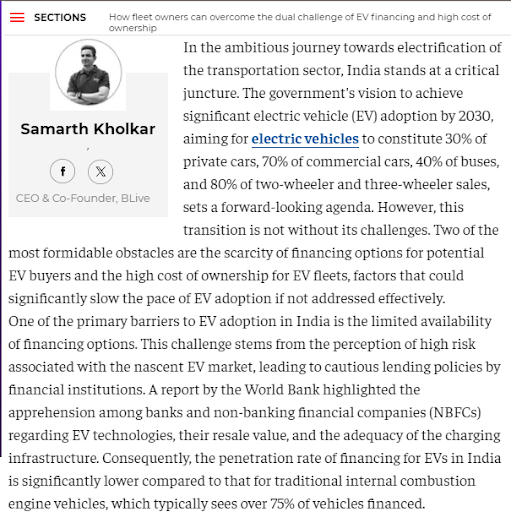-
TrackoBit
Manage commercial vehicles with the new-age Fleet Management Software
TrackoBit -
TrackoField
Streamline your scattered workforce with Field Force Management Software
TrackoField -
Features Resources
-
Blog
Carefully curated articles to update you on industrial trends. -
White Paper
Insightful papers and analysis on essential subject matters. -
Glossary
Explore an alphabetical list of relevant industry terms. -
What’s New
Get TrackoBit & TrackoField monthly updates here. -
Case Study
Explore the cases we solved with our diverse solutions. -
Comparisons
Compare platforms, features, and pricing to find your best fit.
-
About Us
Get to know TrackoBit: our team, ethos, values, and vision. -
Careers
Join the most dynamic cult of coders, creatives and changemakers. -
Tech Support
Learn about our technical support team and services in detail. -
Events
Check out the exhibitions where we left our marks and conquered. -
Contact Us
Connect with us and let us know how we can be of service.
What’s Currently Happening in the Fleet Management Industry?
- Author:Anvesha Pandey
- Read Time:10 min
- Published:
- Last Update: December 17, 2025
Table of Contents
Toggle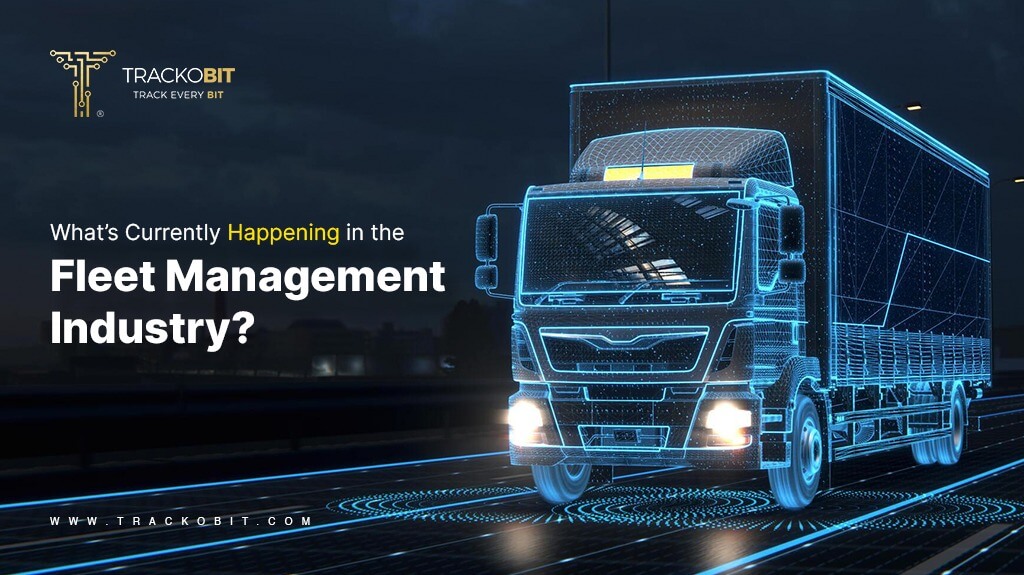
Fleet management is hitting the gas! As AI copilots optimize routes, electric vehicles charge into the scene, and data dashboards give managers a crystal clear view of their operations – the fleet management industry is leaping toward technological advancements. Here’s what is happening in the industry.
Table of Contents
Toggle
Once Henry Ford said, “ Coming together is a beginning, staying together is progress, and working together is a success.” This sentiment is profound in the present scenario of fleet management. Today, we witness the convergence of traditional methodologies with the disruptive force of technological innovation, birthing a new era of efficiency, safety, and sustainable fleet management.
Fleet management has dramatically grown from managing vehicles via AI dashcams to managing autonomous vehicles for safe operations. Earlier, the only constant worry was around fuel costs. But now, as times have changed, fleet owners are more focused on increasing their asset’s safety and sustainable practices. And to support that, they are going all in with cutting-edge technologies like fleet management software.
This piece of writing unfolds what’s currently happening in the fleet management industry, and all the innovations, and breakthroughs that are helping the industry evolve from the old times. So let’s get started.
Latest Trends in the Fleet Management Industry – What’s New?
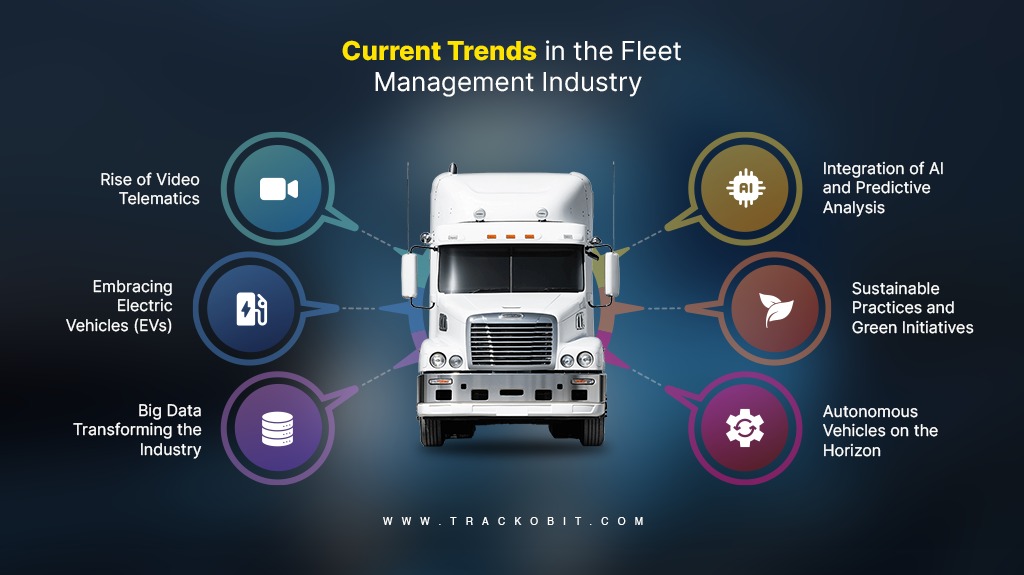
1. Rise of Video Telematics
🔎 According to a report by Market Research Future, the global video telematics market is expected to grow at a CAGR of over 20% between 2021 and 2026.
Undoubtedly, video telematics has been one of the best innovations, especially for logistics and fleet management businesses. In general terms, video telematics involves installing cameras to monitor driver behavior, road conditions, and incidents in real time.
ADAS and DMS are extensions of video telematics that are helping businesses have an active eye on fleet operations in more depth. ADAS is a great way to detect external threats like collisions and DMS is a great solution to detect when the driver is driving without attentiveness on the road.
With ideal video telematics, you get real-time visibility that not only marks the safety of your assets but contributes to the driver’s safety.
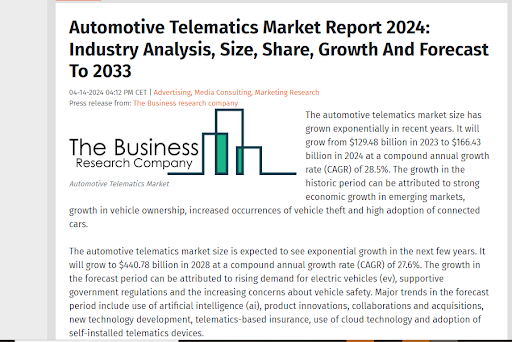
2. Embracing Electric Vehicles (EVs)
🔎The International Energy Agency (IEA) reported that global electric vehicle sales reached a record market share of 4.6% in 2020.
We all know that worldwide economies focus on sustainability and reducing carbon emissions, and most fleet management companies are increasingly adopting electric vehicles. EV fleets are more like a present to the economy. Let’s have a look at some interesting facts:
- You get lower emissions with EVs, in the form of data electric vehicles typically generate 40% fewer emissions than petrol value.
- You save bigs as eclectic vehicles are 70–90% cheaper to operate, potentially saving households more than $2000 per year.
- Logistics is highly dependent on fuel, and with this inflation in the economy increases as the demand for fuel tends to increase. These factors indicate economic instability. So the more quickly we transition to electric vehicles, the more secure our transport system will be.
Additionally, improved cooperation among the government, financial institutions, and the EV industry is facilitating innovative financing models. Subsidies and incentives, like those from the FAME II ( Faster Adoption and Manufacture of Electric Vehicles) scheme, are crucial in making EVs more affordable for consumers and fleet operators. The scheme has allocated INR 10,000 crores to support the deployment of 1 million electric two-wheelers, 500,000 three-wheelers, 55,000 four-wheelers, and 7,000 buses.
DAF (Van Doorne’s Aanhangwagen Fabriek) is leading the way in promoting e-trucks for commercial fleets, despite obstacles. The future of commercial fleets will undoubtedly be dominated by electric trucks.
| 🧩 Worried about managing your growing electric vehicle fleet?
TrackoBit’s EV Fleet Management System provides real-time battery health, SOC monitoring, and live voltage tracking to optimize routes, avoid downtime, and gain valuable insights. Take control of your EV fleet. Contact TrackoBit today for a free consultation! |
3. Big Data is Dominating the Fleet Management Industry
🔎According to a study by MarketsandMarkets, the global fleet management market size is projected to reach $33.9 billion by 2026, driven by the increasing adoption of big data analytics.
BIG DATA- the power pack of logistics and fleet management industries. Gone are the days when businesses only focused on profit maximization without unlayering the “How and Where,” in their daily fleet operations. Today businesses have started focusing on the deep insights of data around the fleet’s real-time locational activity, end-to-end visibility, and maintenance schedule.
No, it’s not like businesses did not collect data previously. They always did! However, given the fact that fleet operations are unfolding, the need to collect a great volume of data around every smallest event is increasing exponentially.
All of this data helps improve fleet efficiency. Real-time locational data can be used to track vehicles’ location and optimize routing. Data around fuel usage and consumption can help plan optimum trips. And data around engine diagnostics can help stay on top of vehicles with longer lifespans.
All these data can directly improve overall fleet management.
This big data is useful in improving fleet management in more indirect ways. For example, big data can be used to predict traffic patterns and plan routes accordingly. Big data can also monitor weather conditions and adjust operations accordingly.
4. Integration of AI and Predictive Analysis
🔎Research by Grand View Research suggests that the global AI in the transportation market is expected to reach $12.22 billion by 2027, driven by advancements in AI technology and the need for efficient transportation systems.
As telematics continues to play a significant role in the fleet management industry, the integration of AI and predictive analytics emerges as a game changer.
The power of predictive analytics lies in the ability to foresee and mitigate potential changes making it an invaluable tool in anticipating vehicle maintenance needs, potential breakdowns, and even predicting traffic patterns.
Modern-day fleet management software is helpful as it provides statistical algorithms and historical data to identify the likelihood of future outcomes based on patterns. When combined with AI, telematics systems gain the ability to learn from data, adapt to changing circumstances, and make informed predictions.
The advent of artificial intelligence (AI) stands as a transformative force, elevating the discipline far beyond conventional GPS tracking. Beyond mere location monitoring, AI plays a pivotal role in analyzing driver behavior, leveraging machine learning to predict potential risky behaviors, and providing real-time feedback to drivers.
5. Sustainable Practices and Green Initiatives
Sustainability has become a key focus for various fleet management companies, with initiatives aimed at environmental impacts and reduced carbon emissions. These practices can involve optimizing routes to minimize fuel consumption and implementing eco-friendly driving practices.
In today’s space, fleet management businesses are opting to improve fleet sustainability with fuel efficiency. Telematics and GPS fleet tracking solutions can be constructive in identifying ways to reduce fuel consumption by lowering idling (Each year, truck idling uses roughly 1 billion gallons of fuel and releases 11 million tons of CO2 into the atmosphere), avoiding harsh driving, and monitoring fuel usage.
In addition, sustainable fleets have opted to go paperless to reduce carbon footprints. Organizations are switching to digital platforms to record drivers’ details, assign trips, tasks, DVIR reports, drivers’ timesheets, generate PODs, maintenance schedules, and more.
Obviously, going all green is not as easy as walking in the park as most diesel trucks have a run range of more than 1500 km on the other hand, we have trucks like the Semi truck by Tesla that are environmentally friendly but have a run range of hardly 800 km. Here’s where we are lacking back.
6. Autonomous Vehicles on the Horizon
🔎 According to a report by Allied Market Research, the global autonomous vehicle market is projected to reach $556.67 billion by 2026, with fleet management being one of the key sectors driving this growth.
The world is evolving, and so is the world of transportation. Self-driving vehicles are no more a dream. Sensors, cameras, and fleet management software backing autonomous trucks will soon be on the roads delivering efficiency.
There are a few names that we can surely table when it comes to autonomous driving: Tesla, IVECO, and Plus. All of them are almost done with the testing. Several fleet management companies are starting to use autonomous trucks as the technology improves fuel efficiency by optimizing speed and reducing unnecessary stops.
This trend is expected to continue growing as sensor technology advances and real-world applications become more sophisticated.
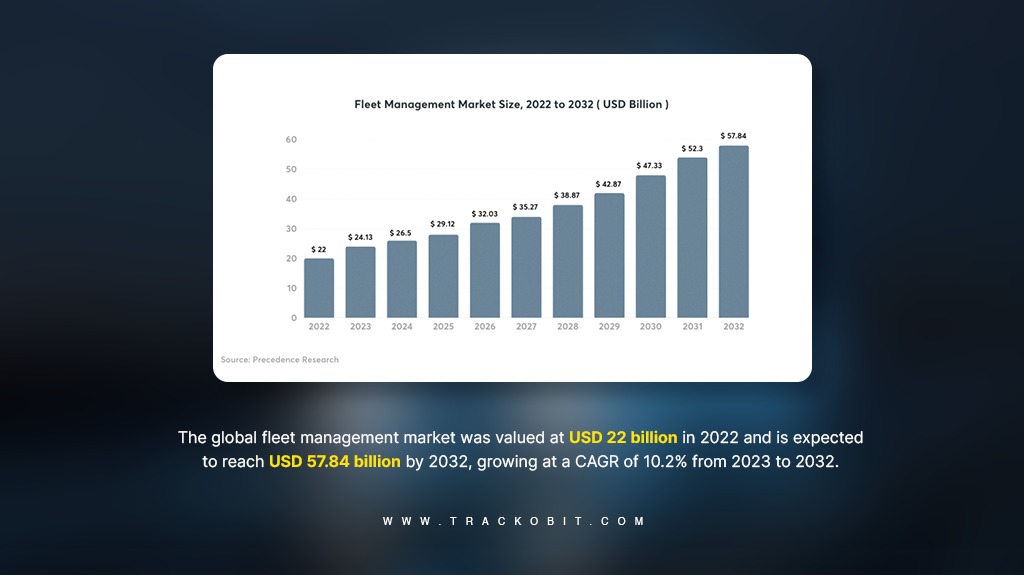
Is Green the New Black in the Current Era of Fleet Management?
Indeed, it will never be wrong to say that ‘Green’ is the new ‘Black’ when it comes to fleet management. As industries worldwide embrace the imperative of environmental sustainability, the transportation sector finds itself at the forefront of this transformative shift.
Today along with focusing on optimized routes and reducing costs, the spotlight of the fleet management industry shines brightly on eco-conscious practices and the adoption of greener technologies.
Various initiatives can be seen supporting the above-mentioned statement like:
- Electric vehicles gliding down urban roads
- Planning innovative strategies for reducing carbon emissions
The color ‘Green’ has become synonymous with progress and profitability in this current era of fleet management.
So you might be wondering if all the things companies are doing to be more environmentally friendly will make the fleet management industry completely green in the future. Well, it’s kind of like when you decide to use less plastic to help the Earth. Some companies are working hard to use cleaner fuels and better technology for their vehicles, which is great for the environment. But right now, not all of them are doing it.
So, while things are getting better, we still have a way to go before the whole fleet management industry is totally green.
Well, the fleet management industry won’t go 100% green shortly as there are limitations to the adoption of green fleets.
1) Less Charging Infrastructure
Electric trucks rely heavily on a network of charging stations for refueling, similar to gas stations for diesel trucks. However, the infrastructure for electric vehicle (EV) charging is still in its nascent stage, particularly in rural areas where trucking routes often traverse. Building a comprehensive charging infrastructure requires substantial investment and coordination among various stakeholders, including government entities, utility companies, and private businesses.
Without a robust network of charging stations along major trucking routes, the practicality of electric trucks for long-haul transportation remains limited, as drivers may face range anxiety and uncertainty about finding charging facilities.
Sounds complicated? Let me explain this to you with an example- The case of the Tesla semi-truck which boasts impressive specs but faces skepticism due to concerns about charging.
2) Less Advanced Batteries
Even with the advancements in battery technologies, charging an electric truck/vehicle takes considerably longer than refueling a diesel truck. For sure fast-charging technologies are emerging, but the charging time for electric trucks is significantly longer than the time it takes to refuel a diesel truck. This prolonged charging time can lead to downtime for drivers and also impact the delivery schedules.
Without convenient and efficient charging solutions, the adoption of electric trucks for long-haul transportation can be hindered.
3) High Initial Costs
We all are somewhat aware that electric trucks typically come with higher upfront costs compared to diesel trucks. This cost difference arises from various factors associated with battery packs, electric drivetrains, and other components required for electric propulsion.
Although there may be potential long-term savings on fuel and maintenance, the higher upfront investment poses a significant challenge for fleet operators, particularly in an industry characterized by slim profit margins and fierce competition.
In the absence of sufficient incentives or subsidies to offset the initial cost disparity, numerous fleet operators may hesitate to switch to electric trucks.
Shift into High Gear with TrackoBit’s Innovative Fleet Management Solutions
We understand a lot is evolving when it comes to the fleet management industry. Here is where having the right fleet management comes into action. It is time to ditch the outdated methods and rev up your operations with TB’s innovative fleet management solutions.
Here’s why TB is your partner to success
- Easy to deploy software
- Better tracking of important KPIs
- Detailed data-led insights into operational events
Ready to experience the difference TrackoBit can help see?
Contact us today for a free demo!
FAQs
-
What challenges and opportunities are associated with autonomous vehicles in fleet management?
While autonomous vehicles promise increased safety and efficiency, challenges such as regulatory hurdles, technological limitations, and public acceptance need to be addressed. However, the potential benefits, including reduced labor costs, improved asset utilization, and enhanced operational efficiency, make autonomous vehicles an enticing prospect for fleet managers looking to stay competitive in the future.
-
How is big data transforming the way fleet management companies operate?
Big data analytics enable fleet management companies to harness the vast amounts of data generated by vehicles, drivers, and operations to optimize routes, predict maintenance needs, monitor fuel consumption, and enhance overall performance. By leveraging data-driven insights, companies can make informed decisions to streamline operations, reduce costs, and improve customer satisfaction.
-
How is the rise of electric vehicles impacting fleet management?
The increasing adoption of electric vehicles in fleet management is reshaping operations by reducing carbon emissions, lowering fuel costs, and requiring adjustments to infrastructure and maintenance practices. Companies are also exploring strategies to overcome challenges like range limitations and charging infrastructure availability.
Anvesha is a communication specialist at TrackoBit. With a strong background in media and communications, she adds much-needed balance and brevity to TrackoBit’s... Read More
Related Blogs
-

When Tracking Needs a Clock: Rethinking Fleet Visibility
Tithi Agarwal December 24, 2025Read on to understand why fleet tracking works better when it follows working hours. Because visibility should support operations, not…
-

What Makes TrackoBit’s Video Telematics Software Truly Next-Gen?
Shemanti Ghosh December 17, 2025TrackoBit’s video telematics software blends smart video intelligence with full server control. The result? Superior fleet reliability and safety.
-

Plug, Pair, Perform TrackoBit Introduces BLE Sensor Integration
Tithi Agarwal November 26, 2025TrackoBit’s BLE Sensor Integration enables wireless, real-time monitoring with faster installs and accurate insights. It improves fleet efficiency, visibility, and…
-

How to Use Driver Behavior Reports as a Sales Hook to Close Big Fleets
Tithi Agarwal October 16, 2025TrackoBit’s driver behavior reports empower fleet providers to win big contracts by showcasing safety, efficiency, and measurable ROI.

Subscribe for weekly tips to optimize your fleet’s potential!
Your inbox awaits a welcome email. Stay tuned for the latest blog updates & expert insights.
"While you're here, dive into some more reads or grab quick bites from our social platforms!"Stay Updated on tech, telematics and mobility. Don't miss out on the latest in the industry.
We use cookies to enhance and personalize your browsing experience. By continuing to use our website, you agree to our Privacy Policy.

































